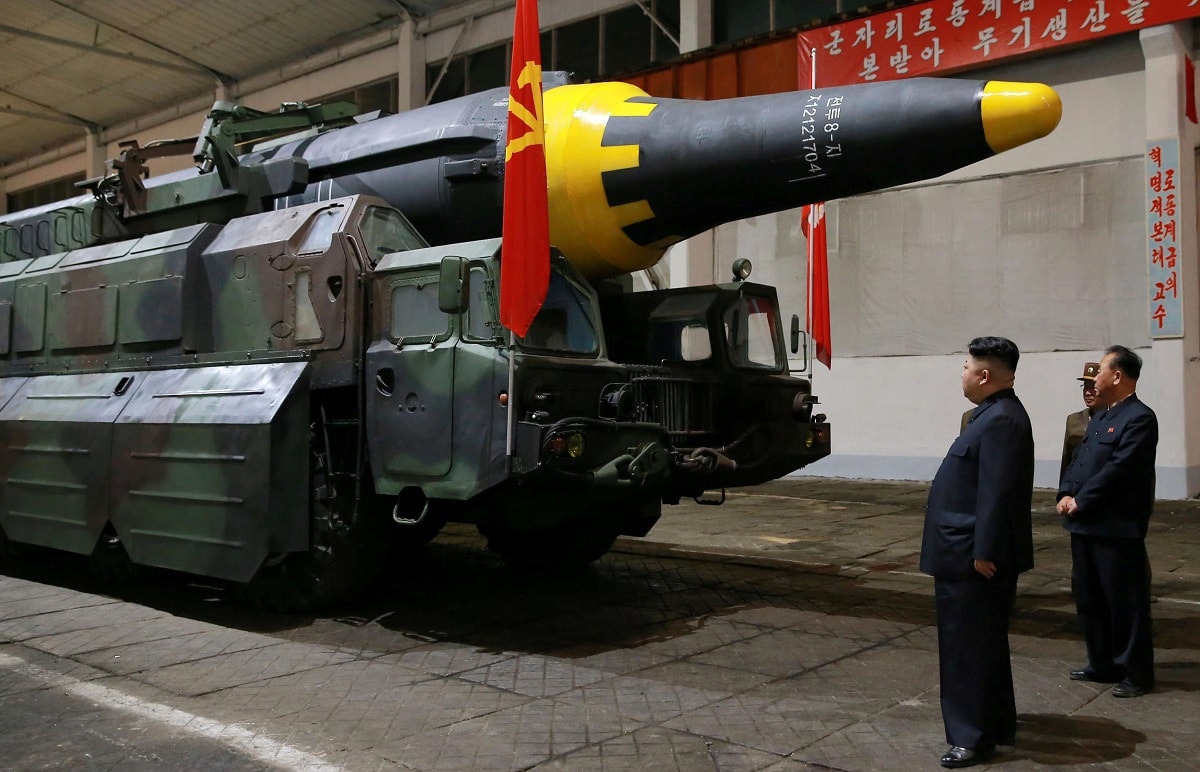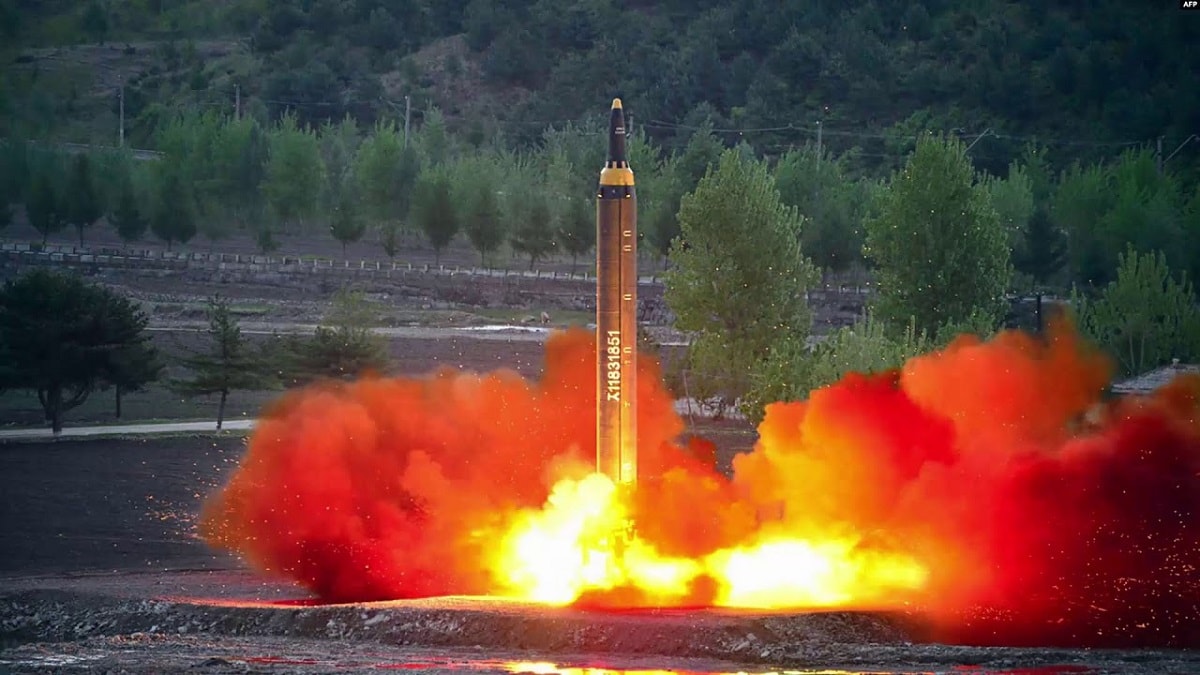North Korea has conducted what appears to be the launch of its longest-capable missile since the November 2017 test of the Hwasong-15 intercontinental-range ballistic missile. On Monday, state media confirmed that the launch involved a Hwasong-12 intermediate-range ballistic missile—one of the major new capabilities that had first been demonstrated in 2017.
According to South Korean authorities, the Hwasong-12 covered a range of 800 kilometers, and reached an altitude of more than 2,000 kilometers.
This type of launch, involving a ‘lofted’ trajectory, shortens the demonstrated range of a given missile. If launched on a normal trajectory, the recently tested missile would range in excess of 3,500 kilometers, enough to reach Guam from North Korea.
North Korean state media released details about what was tested. Kim Jong Un was not present to guide the test and it was presented as a routine operational trial. The Hwasong-12 test appeared to be unchanged from previous tests in 2017. The Academy of Defense Science oversaw the test.
This latest test augurs poorly for 2022. These types of lofted launches of long-range missiles were what made 2017 a particularly notable year for the country’s missile program.
The latest launch indicates the fraying of Kim’s April 2018 moratorium on long-range missile testing better than anything else since then. Earlier this month, at a Politburo meeting, Kim indicated that he saw reason to revisit all “temporarily” suspended military activities, including long-range missile and nuclear testing, in light of the United States’ behavior. (North Korea reacted poorly to new sanctions announced this month by the Biden administration, following its testing of a new maneuverable reentry vehicle.)
According to state media, the Politburo “gave an instruction to a sector concerned to reconsider in an overall scale the trust-building measures that we took on our own initiative on a preferential ground and to promptly examine the issue of restarting all temporally-suspended activities.” The word “promptly” was significant here, as we’re now seeing with the test of an intermediate-range ballistic missile just days later.
The matter of Kim’s April 2018 moratorium is likely to grow in importance in the coming days and weeks. In the aftermath of this latest missile test, South Korean President Moon Jae-in’s administration has described North Korea’s position as close to violating the moratorium.
“North Korea has kept the moratorium on nuclear tests and ICBM launches so far while expressing a willingness for dialogue. But if it did fire an intermediate-range ballistic missile, we can consider they have moved closer to scrapping the moratorium,” Moon said at a plenary meeting of South Korea’s National Security Council on Sunday.
It’s worth recalling what exactly Kim said in April 2018. His moratorium was announced at the 3rd Plenary meeting of the 7th Central Committee of the Workers’ Party of Korea. In describing recent military accomplishments, Kim said that both the testing of intermediate-range ballistic missiles and intercontinental-range ballistic missiles—along with nuclear weapons—was no longer necessary because sufficient capability had been demonstrated.
But Kim followed this by announcing six “resolutions”, or decisions, at the same plenary. The second resolution included the following language: “We will discontinue nuclear test and inter-continental ballistic rocket test-fire from April 21, Juche 107 (2018).” This notably excluded intermediate-range ballistic missiles.
However, the North Koreans would later themselves indicate that the moratorium did include intermediate-range ballistic missiles. For instance, a May 8, 2019, statement, albeit at a far less authoritative level than from Kim Jong Un himself, after the resumption of short-range missile testing pointed out that the United States and Japan, for instance, didn’t see the moratorium as being violated “as the firing of the intermediate and long-range missile and the ICBM was not involved in it.”
Former U.S. Secretary of State Mike Pompeo similarly implied, in the aftermath of the final meeting between former President Trump and Kim Jong Un on June 30, 2019, that Kim had committed “not to conducting nuclear tests, and that he would continue to avoid launching intermediate-range and long-range ballistic missiles.”
It’s unclear if this was a private assurance given from Kim to Trump at either that meeting or the Hanoi summit in February 2019; no public readouts followed either of those meetings, leaving some ambiguity around this matter.
Looking ahead, there is much cause for concern. First, whatever one’s interpretation of the precise contours of Kim’s April 2018 moratorium, there’s little doubt that those assurances are now crumbling. North Korea’s ongoing missile campaign should be expected to pick up in the coming months—particularly as Kim has emphasized the need to commemorate Kim Jong Il’s 80th birthday and Kim Il Sung’s 110th birthday with “splendor” this year.
Second, these tests have tremendous technical value for North Korea as it seeks to improve the reliability of its long-range missiles, which have still only seen limited testing. Other areas for technical progress, including reentry vehicle technology, will also benefit.

Image of Hwasong-12 IRBM. Image Credit: KCNA.

Hwasong-12. Image: YouTube Screenshot.
Ankit Panda is the Stanton Senior Fellow in the Nuclear Policy Program at the Carnegie Endowment for International Peace. An expert on the Asia-Pacific region, his research interests range from nuclear strategy, arms control, missile defense, nonproliferation, emerging technologies, and U.S. extended deterrence. He is the author of Kim Jong Un and the Bomb: Survival and Deterrence in North Korea (Hurst Publishers/Oxford University Press, 2020).
A widely published writer, Panda’s work has appeared in the New York Times, the Washington Post, Foreign Affairs, Foreign Policy, the Bulletin of the Atomic Scientists, the Diplomat, the Atlantic, the New Republic, the South China Morning Post, War on the Rocks, Politico, and the National Interest. Panda has also published in scholarly journals, including Survival, the Washington Quarterly, and India Review, and has contributed to the IISS Asia-Pacific Regional Security Assessment and Strategic Survey. He is editor-at-large at the Diplomat, where he hosts the Asia Geopolitics podcast, and a contributing editor at War on the Rocks.

